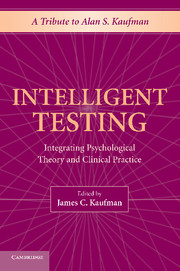Book contents
- Frontmatter
- Contents
- Acknowledgments
- Alphabetical List of Authors and Affiliations
- PART ONE THOSE WHO KNOW HIM
- PART TWO INTELLIGENT TESTING
- 4 Intelligent Testing: Bridging the Gap between Classical and Romantic Science in Assessment
- 5 The Intelligent Testing of Children with Specific Learning Disabilities
- 6 Temperament Preferences for Children Ages 8 Through 17 in a Nationally Represented Sample
- 7 Intelligent Intelligence Testing: The Influence of Alan S. Kaufman
- PART THREE THE INTERSECTION OF THEORY AND MEASUREMENT
- PART FOUR KAUFMAN ACROSS THE WORLD
- Author Index
- Subject Index
- References
4 - Intelligent Testing: Bridging the Gap between Classical and Romantic Science in Assessment
Published online by Cambridge University Press: 05 August 2012
- Frontmatter
- Contents
- Acknowledgments
- Alphabetical List of Authors and Affiliations
- PART ONE THOSE WHO KNOW HIM
- PART TWO INTELLIGENT TESTING
- 4 Intelligent Testing: Bridging the Gap between Classical and Romantic Science in Assessment
- 5 The Intelligent Testing of Children with Specific Learning Disabilities
- 6 Temperament Preferences for Children Ages 8 Through 17 in a Nationally Represented Sample
- 7 Intelligent Intelligence Testing: The Influence of Alan S. Kaufman
- PART THREE THE INTERSECTION OF THEORY AND MEASUREMENT
- PART FOUR KAUFMAN ACROSS THE WORLD
- Author Index
- Subject Index
- References
Summary
INTRODUCTION
One of the many contributions made by Alan Kaufman to the field of psychology in the past 30 years, Intelligent Testing, became the gold standard for psychometric test interpretation and clinical assessment. It was an interpretive system developed by Kaufman (1979, 1994; Kaufman & Lichtenberger, 2004, 2006) during the revisions of the Wechsler scales (Wechsler, 1949, 1974, 1981) and introduced the notion that appropriate use of information gained from any IQ test used in a comprehensive assessment was guided by various clinical principles that incorporated both quantitative and qualitative analyses.
The development of this system was probably a natural response on the part of Kaufman and many others to calm the controversy surrounding the measurement of intelligence in the latter part of the twentieth century. Metatheoretical principles for clinical assessment were needed in the 1970s because impassioned arguments against the misuse of IQ scores were frequent, and, sadly, evidence of misuse was replete (Berninger & O'Donnell, 2005; Fletcher & Reschly, 2005; Prifitera, Weiss, Saklosfse & Rolfus, 2005).
The intelligent testing philosophy was essentially the first system of test interpretation that followed scientific principles and at the same time overtly sought to reduce inappropriate use of obtained test scores. Intelligent testing moved emphasis away from pure psychometric and reductionistic comparisons of test scores and demanded incorporation of a contextual analysis of the test subject and interventions that had ecological validity.
- Type
- Chapter
- Information
- Intelligent TestingIntegrating Psychological Theory and Clinical Practice, pp. 15 - 29Publisher: Cambridge University PressPrint publication year: 2009
References
- 2
- Cited by

